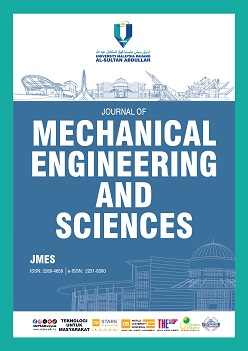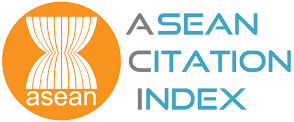Deep learning segmentation of brain ischemic lesion from magnetic resonance images for three-dimensional modelling
DOI:
https://doi.org/10.15282/jmes.19.1.2025.7.0824Keywords:
Brain stroke, Image segmentation, Deep learning, Brain modellingAbstract
Automated segmentation is important for early detection and treatments to reduce disability and death risks among brain stroke patients. The existing segmentation algorithm is limited due to its computationally expensiveness in achieving a small accuracy. This work aims to develop a computationally economical automated brain infarct segmentation from T1-weighted Magnetic Resonance Imaging (MRI) using convolutional neural network architecture U-Net, but with reasonable accuracy compared to existing algorithm. The data used is taken from the Anatomical Tracing of Lesion After Stroke (ATLAS) open-source dataset, consisting of 304 brain t1-weigthed MRI images. The data is divided into training, test, and validation sets according to the 8:1:1 ratio. The data is then pre-processed so that all of them have similar size for the U-Net input. Then, the U-Net architecture is generated using encoder depth of 7. Certain hyperparameters including the number of epochs, encoder depth, and optimizers are varied. The U-Net with encoder depth 7 and using Adam optimizer gives the highest accuracy and loss, which are 92.33% and 0.9771, respectively. Further comparison with previous works shows that the present U-Net beaten the regular U-Net and also gives relatively similar accuracy and loss. Future improvements on the present U-Net is necessary so that the accuracy can be increased further, computationally economic, and to produce a near accurate semantic segmentation of brain lesion.
References
[1] A. Krizhevsky, I. Sutskever, G. E. Hinton, “ImageNet classification with deep convolutional neural networks,” Communications of the ACM, vol. 60, no. 6, pp. 84–90, 2017.
[2] Y. LeCun, B. Boser, J. S. Denker, D. Henderson, R. E. Howard, W. Hubbard, L. D. Jackel, “Backpropagation applied to handwritten zip code recognition,” Neural Computation, vol. 1, no. 4, pp. 541-551, 1989.
[3] K. Simonyan, “Large-scale learning of discriminative image representations,” Ph.D. Thesis, University of Oxford, United Kingdom, 2013.
[4] D. C. Cireşan, A. Giusti, L. M. Gambardella, & J. Schmidhuber, “Mitosis detection in breast cancer histology images with deep neural networks,” in Medical Image Computing and Computer-Assisted Intervention (MICCAI 2013), pp. 411-418, 2013.
[5] O. Ronneberger, P. Fischer, T. Brox, “U-Net: Convolutional networks for biomedical image segmentation,” in Medical Image Computing and Computer-Assisted Intervention (MICCAI 2015), pp. 234-241, 2015.
[6] K. Qi, H. Yang, C. Li, Z. Liu, M. Wang, Q. Liu, et al., “X-Net: Brain stroke lesion segmentation based on depthwise separable convolution and long-range dependencies,” in Medical Image Computing and Computer Assisted Intervention (MICCAI 2019), pp 247-255, 2019.
[7] B. Zhang, Y. Wang, C. Ding, Z. Deng, L. Li, Z. Qin, et al., “Multi-scale feature pyramid fusion network for medical image segmentation,” International Journal of Computer Assisted Radiology and Surgery, vol. 18, no. 2, pp. 353-365, 2023.
[8] K. L. Ito, A. Kumar, A. Zavaliangos-Petropulu, S. C. Cramer, S. -L. Liew, “Pipeline for analyzing lesions after stroke (PALS),” Frontiers in Neuroinformatics, vol. 12, pp. 1-12, 2018.
[9] Y. Zhang, J. Wu, Y. Liu, Y. Chen, E. X. Wu, X. Tang, “MI-UNet: Multi-inputs UNet incorporating brain parcellation for stroke lesion segmentation from T1-weighted magnetic resonance images,” IEEE Journal of Biomedical and Health Informatics, vol. 25, no. 2, pp. 526-535, 2021.
[10] S. -L. Liew, J. M. Anglin, N. W. Banks, M. Sondag, K. L. Ito, H. Kim, et al., “A large, open source dataset of stroke anatomical brain images and manual lesion segmentations,” Scientific Data, vol. 5, p. 180011, 2018.
[11] M. J. Mohamed Mokhtarudin, A. Shabudin, S. J. Payne, “Effects of brain tissue mechanical and fluid transport properties during ischaemic brain oedema: A poroelastic finite element analysis,” in IEEE-EMBS Conference on Biomedical Engineering and Sciences (IECBES), pp. 1-6, 2018.
[12] K. Kipli, A. Z. Kouzani, “Degree of contribution (DoC) feature selection algorithm for structural brain MRI volumetric features in depression detection,” International Journal of Computer Assisted Radiology and Surgery, vol. 10, no. 7, pp. 1003-1016, 2015.
[13] T. Shelatkar, D. Urvashi, M. Shorfuzzaman, A. Alsufyani, K. Lakshmanna, “Diagnosis of brain tumor using light weight deep learning model with fine-tuning approach,” Computational and Mathematical Methods in Medicine, vol. 2022, no. 1, pp. 1-9, 2022.
[14] W. Sun, R. Wang, “Fully convolutional networks for semantic segmentation of very high resolution remotely sensed images combined with DSM,” IEEE Geoscience and Remote Sensing Letters, vol. 15, no. 3, pp. 474-478, 2018.
[15] M. Yazdani, “An Example of Architecture of U-Net,” Wikimedia Commons [Online], 2019. Available: https://commons.wikimedia.org/w/index.php?curid=81055729
[16] S. Choi, K. Lee, “A CUDA-based implementation of convolutional neural network,” in 4th International Conference on Computer Applications and Information Processing Technology (CAIPT), pp. 1-4, 2017.
[17] H. Alquhayz, H. Z. Tufail, B. Raza, “The multi-level classification network (MCN) with modified residual U-Net for ischemic stroke lesions segmentation from ATLAS,” Computers in Biology and Medicine, vol. 15, p. 106332, 2022.
[18] J. Lee, M. Lee, J. Lee, R. E. Y. Kim, S. H. Lim, D. Kim, “Fine-grained brain tissue segmentation for brain modeling of stroke patient,” Computers in Biology and Medicine, vol. 15, p. 106472, 2023.
[19] X. Liu, H. Yang, K. Qi, P. Dong, Q. Liu, X. Liu, et al., “MSDF-Net: Multi-scale deep fusion network for stroke lesion segmentation,” IEEE Access, vol. 7, pp. 178486-178495, 2019.
[20] X. Y. Lee, M. J. Mohamed Mokhtarudin, R. Junid, “Brain lesion image segmentation using modified U-net architecture,” in Intelligent Manufacturing and Mechatronics, pp. 549-555, 2024.
[21] Y. Zhou, W. Huang, P. Dong, Y. Xia, S. Wang, “D-UNet: A dimension-fusion U shape network for chronic stroke lesion segmentation,” IEEE/ACM Transactions on Computational Biology and Bioinformatics, vol. 18, no. 3, pp. 940-950, 2021.
[22] Z. Wu, X. Zhang, F. Li, S. Wang, L. Huang, J. Li, “W-Net: A boundary-enhanced segmentation network for stroke lesions,” Expert Systems with Applications, vol. 230, p. 120637, 2023.
[23] P. Vilela, H. A. Rowley, “Brain ischemia: CT and MRI techniques in acute ischemic stroke,” European Journal of Radiology, vol. 96, pp. 162-172, 2017.
[24] M. Yanzhen, C. Song, L. Wanping, Y. Zufang, A. Wang, “Exploring approaches to tackle cross-domain challenges in brain medical image segmentation: a systematic review,” Frontier in Neuroscience, vol. 18, pp. 1-18, 2024.
[25] S. J. Warach, M. Luby, G. W. Albers, R. Bammer, A. Bivard, B. C. V. Campbell, et al., “Acute stroke imaging research roadmap III imaging selection and outcomes in acute stroke reperfusion clinical trials,” Stroke, vol. 47, no. 5, pp. 1389-1398, 2016.
[26] A. N. Nadzri, N. A. Nik Mohamed, S. J. Payne, M. J. Mohamed Mokhtarudin, “Poroelastic modelling of brain tissue swelling and decompressive craniectomy treatment in ischaemic stroke,” Computer Methods in Biomechanics and Biomedical Engineering, pp. 1-11, 2024.
[27] A. N. Nadzri, M. J. Mohamed Mokhtarudin, W. N. Wan Ab Naim, S. Payne, “Simulation of craniectomy size in decompressive craniectomy for ischaemic stroke,” in Enabling Industry 4.0 Through Advances in Manufacturing and Materials, pp. 599-607, 2022.
[28] A. N. Nadzri, M. J. Mohamed Mokhtarudin, W. N. Wan Ab Naim, S. J. Payne, “Simulation of decompressive craniectomy for ischaemic stroke treatment: a conceptual modeling study,” in 2020 IEEE-EMBS Conference on Biomedical Engineering and Sciences (IECBES), pp. 303-308, 2021.
[29] X. Chen, T. I. Józsa, D. Cardim, C. Robba, M. Czosnyka, S. J. Payne, “Modelling midline shift and ventricle collapse in cerebral oedema following acute ischaemic stroke,” PLoS Computational Biology, vol. 20, no. 5, p. e1012145, 2024.
[30] F. Yepes-Calderon, J. G. McComb, “Eliminating the need for manual segmentation to determine size and volume from MRI. A proof of concept on segmenting the lateral ventricles,” PLoS One, vol. 18, no. 5, p. e0285414, 2023.
Downloads
Published
Issue
Section
License
Copyright (c) 2025 The Author(s)

This work is licensed under a Creative Commons Attribution-NonCommercial 4.0 International License.






